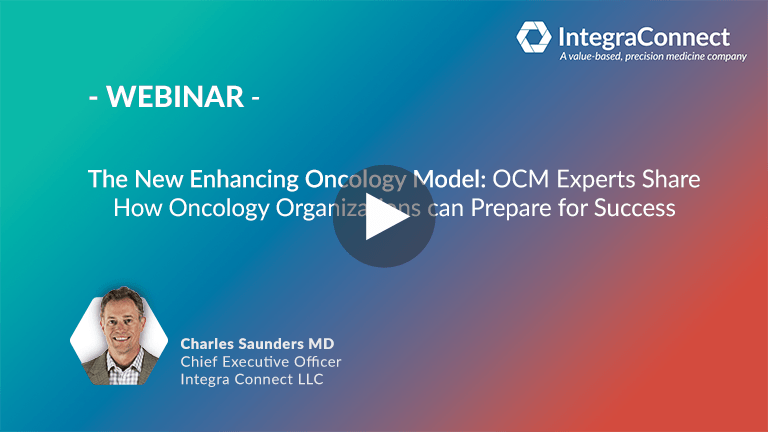by Dr. Charles Saunders, CEO of Integra Connect.
The Oncology Care Model (OCM) came to an end in June of 2022, giving oncology providers, payers, and other industry observers the opportunity to break down the results of CMS’ flagship value-based care program before its successor, the Enhancing Oncology Model (EOM), begins in 2023.
Five years ago, OCM enlisted the help of major commercial insurance plans to improve the efficiency and effectiveness of cancer care by offering two types of financial incentives to transform practices and adopt principles of value-based oncology care under the oncology medical home model: a per-member-per-month enhanced oncology services fee (MEOS) and additional performance-based payments that allowed for a share of savings and meeting specific quality benchmarks.
OCM was a 5-year model which measured the total cost of care during a 6-month episode of cancer treatment in which chemotherapy was administered. If the total actual costs for the episode, including MEOS payments, were less than a projected risk and trend-adjusted benchmark, then the episode would have been judged a success. Net savings would be available to share with practices, provided quality measured thresholds were met.
Unfortunately, by this definition, the model did not fully deliver. According to CMS results from the first five performance periods of the program, the OCM did reduce spending on cancer care, but not enough to exceed the MEOS payments in the aggregate. Net losses to Medicare totaled $61M to $100M in each of the first five pay periods.
The news caused a ripple of uncertainty across the industry: what do these losses mean for the future of value-based care?
As is always the case in healthcare, the answers are not cut-and-dry. By taking a closer look at the data, we can see that the OCM actually did bring measurable net savings to selected cancer types, along with improvements on important indicators of quality.
In this two-part blog series, we will examine the available data on OCM’s performance and the ways in which the next iteration of the program, the Enhancing Oncology Model (EOM), has the potential to successfully pick up where OCM left off in the pursuit of better experiences and more effective cancer care – if it can improve upon OCM’s limitations.
A second opinion on the outcome of the Oncology Care Model
There are several reasons why we need a “pair of fresh eyes” to look at OCM’s overall performance before making any negative predictions about EOM’s chances. First, CMS has only published results from the first five out of eleven performance periods, the last of which concluded just recently in June of 2022. That means we are judging the success or failure of the program based on information from the ramp up period as practices were adjusting to new performance criteria and altered workflows.
From the sixth performance period onwards, an internal analysis of data from our network of participating oncology providers saw a leveling-off of the growth in expense and an increase in savings with each performance period. Therefore, CMS’ conclusion could be premature.
Second, there is more than one way to define success. Based on their data for the first five periods, CMS is correct that the overall spend for the five initial performance periods exceeded savings to the program. However, the same data shows that net savings were, in fact, realized if common but low-risk breast and prostate cancers are excluded. Because providers still received the same MEOS payment for low-risk breast and prostate cancer patients as they did for more complex patients, these specific cancers placed a significant cost burden on the program without contributing to savings elsewhere.
Third, directly comparing OCM practices to non-OCM practices is comparing “apples to oranges”. Every oncology practice is different, and each participant (or non-participant) made a conscious decision about whether or not the model was right for their organization. This self-selection creates bias in such comparison data and makes it more difficult to gain a clear picture of the results.
On the other hand, CMS uses a different methodology for determining performance-based payment eligibility by comparing a practice’s actual total cost, including MEOS, for each performance period against its “benchmark” price (its risk and trend-adjusted baseline.)
Using this approach, the actual episode costs for most practices in our network were less than benchmark, resulting in net savings, and the magnitude grew through the ensuing nine performance periods. While there may be confounding variables at play from one period to the next, it is likely that practice transformation investments, learnings, and cultural change occurred over time and that the impact of those changes grew as they came to fruition.
In addition to these factors, providers took issue with other challenges in the model, including the untimeliness of feedback data from CMS, the lack of transparency regarding patient attribution, the use of a practice’s own baseline as a comparator, the lack of specificity regarding cancer diagnoses and stage of disease, and the imperfect adjustment for new novel therapies.
Exploring the bright side of OCM
OCM wasn’t an unqualified success, but it also wasn’t an unqualified failure. Some practices did achieve significant positive results throughout the program and were able to accrue financial incentives while improving quality for their patients. Stay tuned for the second half of this blog series, in which we will break down the factors that made some oncology practices more successful within OCM and discuss how the next iteration of value-based care for oncology practices, the Enhancing Oncology Model, will build on the strong foundation that OCM put into place.

